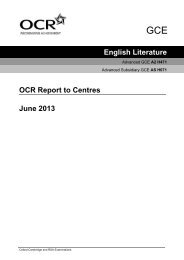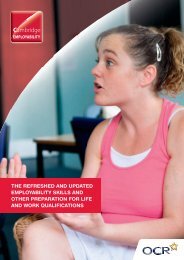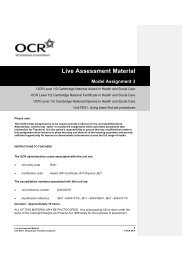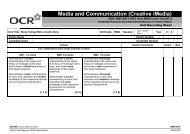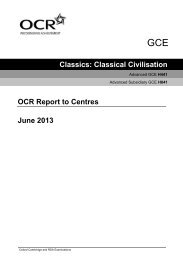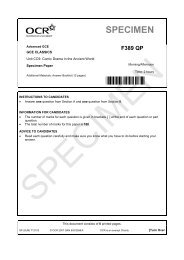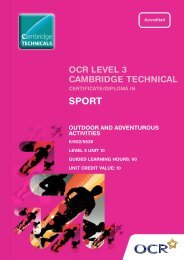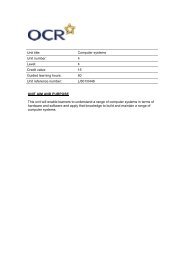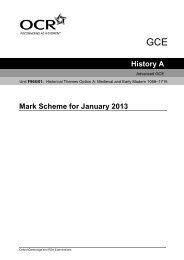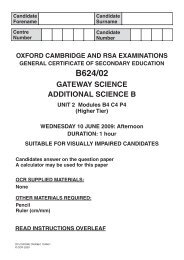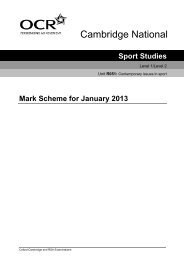SPECIMEN - OCR
SPECIMEN - OCR
SPECIMEN - OCR
You also want an ePaper? Increase the reach of your titles
YUMPU automatically turns print PDFs into web optimized ePapers that Google loves.
Advanced Subsidiary GCE<br />
CHEMISTRY A<br />
Unit F323: Practical Skills in Chemistry 1:<br />
Evaluative Task<br />
Specimen Task<br />
For use from September 2008 to June 2009.<br />
Candidates answer on the task sheet.<br />
<strong>SPECIMEN</strong><br />
F323 (3)<br />
All items required by teachers and candidates for this task are included in this pack.<br />
INFORMATION FOR CANDIDATES<br />
� Evaluative Task: Acid/carbonate reaction<br />
INFORMATION FOR TEACHERS<br />
� Mark scheme.<br />
� Instructions for Teachers and Technicians.<br />
SP (SLM) T12103 © <strong>OCR</strong> 2007 QAN 500/2425/5 <strong>OCR</strong> is an exempt Charity [Turn Over
Advanced Subsidiary GCE<br />
CHEMISTRY A<br />
Unit F323: Practical Skills in Chemistry 1:<br />
Evaluative Task<br />
Specimen Task<br />
For use from September 2008 to June 2009.<br />
Candidates answer on this task sheet.<br />
INSTRUCTIONS TO CANDIDATES<br />
� Answer all parts of the task.<br />
<strong>SPECIMEN</strong><br />
F323 (3)<br />
INFORMATION FOR CANDIDATES<br />
� The number of marks is given in brackets [ ] at the end of each part of the task.<br />
� The total number of marks for this task is 15.<br />
INFORMATION FOR TEACHERS<br />
� Before carrying out this task, it would normally be expected that candidates will have carried out Unit<br />
F323 Task 2: ‘Calculating the relative atomic mass of lithium’.<br />
ADVICE TO CANDIDATES<br />
� Read each part carefully and make sure you know what you have to do before starting your answer.<br />
This task consists of 6 printed pages.<br />
FOR TEACHER’S USE<br />
Part Max. Mark<br />
C1 5<br />
C3 5<br />
C4 5<br />
TOTAL 15<br />
SP (SLM) T12103 © <strong>OCR</strong> 2007 QAN 500/2425/5 <strong>OCR</strong> is an exempt Charity [Turn Over
2<br />
Acid/carbonate reaction<br />
A student suggested that it would be possible to calculate the volume of carbon dioxide evolved<br />
from the reaction of a Group 2 carbonate with sulfuric acid using the following apparatus.<br />
Procedure<br />
A 50.0 cm 3 sample of 0.100 mol dm –3 sulfuric acid was measured using a pipette. This was<br />
added to the flask with the side arm.<br />
0.30 g of magnesium carbonate, MgCO3, was accurately weighed on a digital balance.<br />
The measuring cylinder was filled with exactly 100 cm 3 of water and supported upside down in a<br />
trough of water.<br />
The two pieces of apparatus were connected by a delivery tube so that any gas produced in the<br />
side arm flask would be collected in the measuring cylinder. The apparatus was airtight and no<br />
leaks were present.<br />
The rubber bung was removed from the side arm flask. The MgCO3 was quickly added and the<br />
bung replaced.<br />
Bubbles of carbon dioxide were seen collecting in the measuring cylinder.<br />
When no more gas was seen to collect in the measuring cylinder, the volume of gas collected<br />
was recorded as 64 cm 3 .
Analysis<br />
3<br />
(a) Construct a fully balanced equation for the reaction between H2SO4 and MgCO3, including<br />
state symbols.<br />
........................................................................................................................................... C1 [1]<br />
(b) Calculate the number of moles of H2SO4 and MgCO3 used in the experiment.<br />
(c) State and explain whether the H2SO4 or MgCO3 is in excess.<br />
moles H2SO4 =.........................mol........... C1[1]<br />
moles MgCO3 =.......................mol ........... C1[1]<br />
.................................................................. C1[1]<br />
(d) Show by calculation that the expected volume of carbon dioxide is greater than the 64 cm 3<br />
obtained.<br />
Assume that one mole of CO2 occupies 24.0 dm 3 under the conditions used in the<br />
experiment.<br />
volume CO2 =......................... cm 3 ........... C1[1]<br />
[Turn over
Evaluation<br />
(a) The volume of gas obtained by a student carrying out this practical work was significantly<br />
4<br />
less than the calculated volume. One procedural error is the time lag in replacing the bung.<br />
Suggest one other possible error with the procedure above. Outline why this error would<br />
lead to less gas being collected than expected.<br />
.....................................................................................................................................................<br />
.....................................................................................................................................................<br />
........................................................................................................................................... C3 [1]<br />
(b) Her friend suggested that there would be large errors with the measurements made<br />
because the measuring equipment was not accurate enough.<br />
(i) The 100 cm 3 measuring cylinder used to measure the water was calibrated to within<br />
1 cm 3 .<br />
Calculate the percentage error in the volume of CO2(g) collected in this experiment<br />
using this measuring cylinder.<br />
(ii) The balance used to measure 0.30 g of MgCO3 was accurate to 0.01 g.<br />
State and explain whether the balance or the measuring cylinder contributed most to<br />
the measurement errors in this experiment.<br />
C3 [1]<br />
..............................................................................................................................................<br />
..............................................................................................................................................<br />
..............................................................................................................................................<br />
..............................................................................................................................................<br />
.................................................................................................................................... C3 [2]
5<br />
(c) In the procedure 0.100 mol dm –3 sulfuric acid was measured out using a 25.0 cm 3 pipette<br />
accurate to 0.06 cm 3 to reduce the possible errors in the experiment. The pipette was used<br />
twice to obtain the 50.0 cm 3 .<br />
State and explain why a piece of apparatus with such a high degree of accuracy is not<br />
needed in this case.<br />
.....................................................................................................................................................<br />
.....................................................................................................................................................<br />
........................................................................................................................................... C3 [1]<br />
(d) The students decided that the experiment could be carried out more accurately if both the<br />
procedure and measuring apparatus were modified.<br />
(i) Draw a labelled diagram to show how the carbonate and acid could be reacted together<br />
without needing to remove the bung from the flask.<br />
(ii) Suggest another modification to the general procedure that would produce more<br />
reliable and accurate results.<br />
C4 [2]<br />
..............................................................................................................................................<br />
................................................................................................................................... C4 [1]<br />
(e) The same method was used to measure the volume of carbon dioxide produced when<br />
magnesium carbonate reacted with hydrochloric acid.<br />
Suggest, with reasons, any modifications you may need to make if the sulfuric acid used in<br />
the procedure was replaced with the same concentration and volume of hydrochloric<br />
acid.<br />
.....................................................................................................................................................<br />
.....................................................................................................................................................<br />
.......................................................................................................................................... C4 [2]<br />
END OF TASK<br />
Total [15]<br />
Total [15]
Copyright Acknowledgements:<br />
6<br />
Permission to reproduce items where third-party owned material protected by copyright is included has been sought<br />
and cleared where possible. Every reasonable effort has been made by the publisher (<strong>OCR</strong>) to trace copyright<br />
holders, but if any items requiring clearance have unwittingly been included, the publisher will be pleased to make<br />
amends at the earliest opportunity.<br />
<strong>OCR</strong> is part of the Cambridge Assessment Group. Cambridge Assessment is the brand name of University of<br />
Cambridge Local Examinations Syndicate (UCLES), which is itself a department of the University of Cambridge.<br />
© <strong>OCR</strong> 2007
OXFORD CAMBRIDGE AND RSA EXAMINATIONS<br />
Advanced Subsidiary GCE<br />
CHEMISTRY A F323<br />
Unit F323: Practical Skills in Chemistry 1: Evaluative Task<br />
Specimen Mark Scheme<br />
The maximum mark for this task is 15.<br />
Instructions for teachers<br />
Before carrying out this task, it would normally be expected that candidates will have<br />
carried out Unit F323 Task 2: ‘Calculating the relative atomic mass of lithium’.<br />
For use from September 2008 to June 2009.<br />
SP (SLM) T12103 © <strong>OCR</strong> 2007 QAN 500/2425/5 <strong>OCR</strong> is an exempt Charity [Turn Over
2<br />
Quality C1<br />
writes correct equation and state symbols<br />
H2SO4(aq) + MgCO3(s) → MgSO4(aq) + H2O(l) + CO2(g)<br />
calculates correctly the number of moles of H2SO4 (5.00 × 10 –3 mol)<br />
calculates correctly the number of moles of MgCO3 (3.56 × 10 –3 mol)<br />
explains why H2SO4 is in excess<br />
calculates correctly the volume of CO2 (71.4 cm 3 ) [1]<br />
(a) gas soluble in water<br />
Quality C3<br />
b(i) 1.56% error for measuring cylinder<br />
b(ii) states that the most significant error is the mass measurement<br />
justifies why the balance has the greatest error (3% error)<br />
(c) explains that sulfuric acid is in excess so the quantity is not significant<br />
Quality C4<br />
d(i) arrangement in conical flask that keeps carbonate and acid separate<br />
and which would allow them to be mixed easily without removing bung<br />
equipment used that is available in the laboratory<br />
d(ii) better gas collection method, e.g. syringe (not over water)<br />
(e) explains that the stoichiometry means that with same quantity of HCl<br />
the acid is not in excess<br />
so double the volume of HCl is required<br />
[1]<br />
[1]<br />
[1]<br />
[1]<br />
[1]<br />
[1]<br />
[1]<br />
[1]<br />
[1]<br />
[1]<br />
[1]<br />
[1]<br />
[1]<br />
[1]<br />
Total: [15]
Oxford Cambridge and RSA Examinations<br />
Advanced Subsidiary GCE<br />
CHEMISTRY A F323<br />
Unit F323: Practical Skills in Chemistry 1: Evaluative Task<br />
Instructions for Teachers and Technicians<br />
For use from September 2008 to June 2009.<br />
This document consists of 2 printed pages.<br />
SP (SLM) T12103 © <strong>OCR</strong> 2007 QAN 500/2425/5 <strong>OCR</strong> is an exempt Charity [Turn Over
This is an Evaluative Task. There is no time limit but it is expected that it can be<br />
completed within one hour.<br />
Candidates may attempt more than one evaluative task with the best mark from this type of<br />
task being used to make up the overall mark for Unit F323.<br />
Preparing for the assessment<br />
It is expected that before candidates attempt Practical Skills in Chemistry 1 (Unit F323) they<br />
will have had some general preparation in their lessons. They will be assessed on a number<br />
of qualities such as recognising and interpreting data, identifying anomalies and reaching<br />
valid conclusions, assessing the reliability and accuracy of an experimental task, identifying<br />
significant weaknesses in experimental procedures and measurements, and understanding<br />
and selecting simple improvements to experimental procedures and measurements. It is<br />
therefore essential that they should have some advance practice in these areas so that they<br />
can maximise their attainment.<br />
Preparing candidates<br />
At the start of the task the candidates should be given the task sheet.<br />
Candidates must work on the task individually under controlled conditions with the<br />
completed task being submitted to the teacher at the end of the lesson. Completed tasks<br />
should be kept under secure conditions until results are issued by <strong>OCR</strong>.<br />
Candidates should not be given the opportunity to redraft their work, as this is likely to<br />
require an input of specific advice. If a teacher feels that a candidate has under-performed,<br />
the candidate may be given an alternative task. In such cases it is essential that the<br />
candidate be given detailed feedback on the completed assessment before undertaking<br />
another Evaluative Task. Candidates are permitted to take each task once only.<br />
Assessing the candidate’s work<br />
The mark scheme supplied with this pack should be used to determine a candidate’s mark<br />
out of a total of 15 marks. The cover sheet for the task contains a grid for ease of recording<br />
marks. To aid moderators it is preferable that teachers mark work using red ink, including<br />
any appropriate annotations to support the award of marks.<br />
2




